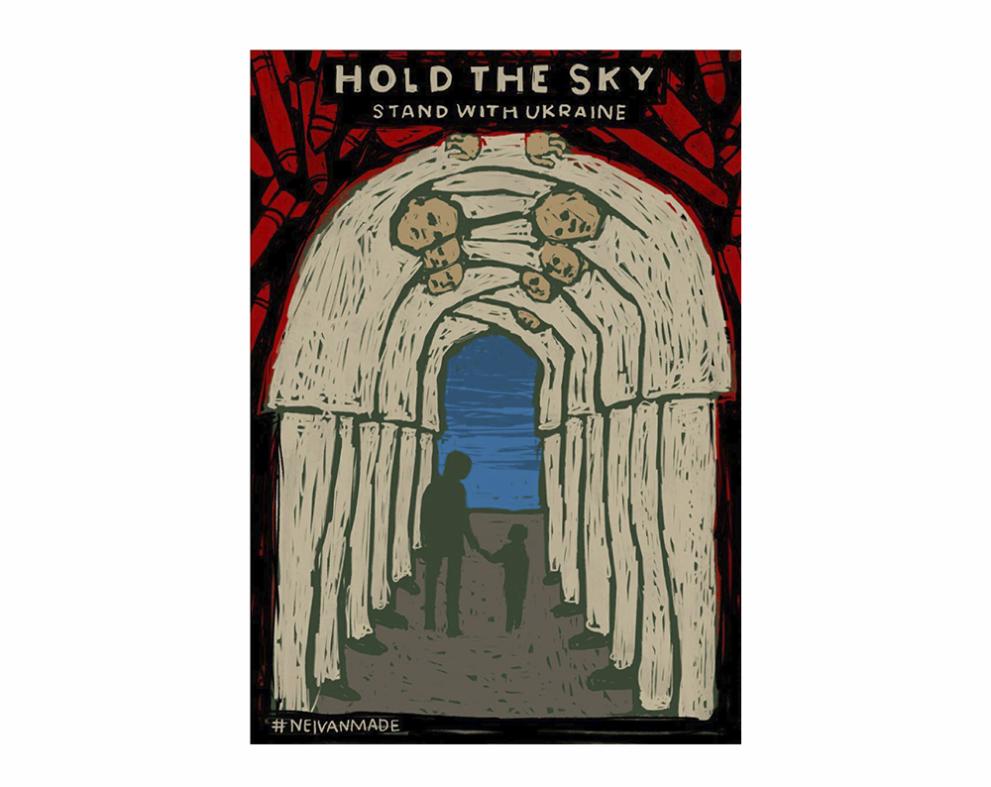On 24 February 2022, Russia invaded Ukraine. As a history museum, the House of European History team felt it was a clear priority to immediately document what was happening, and to collect objects, images, sounds, and opinions about the war.
Poster exhibition
The first month of the war coincided with the installation of the museum’s fourth temporary exhibition When Walls Talk! Posters – promotion, propaganda and protest. Through social media research and contact with the Lviv Municipal Art Centre, the House of European History acquired the rights to a series of twenty-four powerful posters for our collection. Two posters by Ukrainian artists and one poster by a Polish designer were chosen for the When Walls Talk! exhibition
The first poster, a work by Zakentiy Horobyov—the artistic name of the Ukrainian graphic designer, typographer, and illustrator Denys Kuzmenko—is a satirical and thought-provoking work that comments on megalomania, the thirst for power, while inviting the viewer to reflect on the role of the individual in politics and history.
Zakentiy Horobyov - graphic designer, typographer, and illustrator Denys Kuzmenko

The second Ukrainian poster is an emotional work created on 1 March 2022, during the immense shock of the first week of the war, by the artist Mykhailo Skop, who usually signs with his social account nickname #NEIVANMADE. The poster is computer-drawn, in a technique that imitates linocuts, a medium that Skop associates with the immediacy of folk art.
By the artist Mykhailo Skop

A third poster collected and featured in the exhibitions was by Anita Korynek, from Poland. The idea behind it is simple but engaging. A cardiogram divides the surface into two parts, with the part above the line in blue and the part below it in yellow, the national colours of Ukraine. The design and the lettering with the words серце Європи (‘the heart of Europe’ in Ukrainian) express the idea that the heart of Europe beats in solidarity with Ukraine.
By Anita Korynek

Oral testimonies
The Lviv Center for Urban History brought together an international consortium, including the House of European History, to conduct interviews with people displaced by the Russian invasion of Ukraine and those who are working to support them in Ukraine and other countries. The project is called ‘24.02.22, 5 am. Testimonies of War’ and aims to document the human dimension of the war. As oral historians and scholars of cultural memory have shown, personal testimony changes significantly over time, as it is influenced by institutional usage and becomes formalised through repetition. The opportunity here was to support a research action that started in Ukraine and work with Ukrainian scholars on a documenting initiative that involved the ongoing war, thus preserving a historical record of mass human displacement, resistance, and volunteering, while it was still a lived experience.
City of Irpin
Through cooperation with the “Ukrainian HUB” in the European Parliament in Brussels and the City of Irpin, thirteen original objects were acquired from the city destroyed by the Russian army. Some of these objects will be exhibited in the permanent exhibition on the sixth floor in the section ´Headlines of our time´, for example the door of a car destroyed during an attack on people who were trying to escape the town. The forthcoming touring exhibition "Fake for Real", will also feature a selection of these objects, depicting how the concept of ‘fake news’ has affected the Ukraine war.

In the first days and weeks of the war, volunteers helped Ukrainian refugees at the Romanian-Ukrainian border to attain food and find heat and accommodation after tens of hours of travel. The volunteers wore T-shirts with a welcoming message that was designed by the well-known artist Dan Perjovschi. Four such T-shirts are now in the House of European History collection, including one which is currently exhibited in the Europe Now section of the permanent exhibition.
Volunteers from the Republic of Moldova wearing the T-shirts ‘I am here to help you’ in front of their hotel in Suceava (Romania).

The illustrated war diary of artist Olga Grebennik was a highly precious acquisition for the museum. In its pages, Grebennik documents in black and white sketches and fragments of dialogue life in a Kharkiv basement under bombardment and her flight from Ukraine with her two small children and the family dog. The curatorial team came across the diary in its first Romanian edition (Grebennik, 2022) and decided to contact the artist to acquire the original. In the meantime, the war diary has been published in five more countries: Italy, Germany, Japan, Taiwan, and South Korea.
Olga Grebennik, War Diary. Acquired 2022, EU, EP, House of European History, Brussels.

For further information on the Ukraine collecting action, please see the academic article Tomorrow’s History in the Museum. Collecting Testimonies of Current Events for the House of European History in Culture. Society. Economy. Politics - Volume 2 (2022) - Issue 2 - "Museums. Communities, and Society" (open access).
